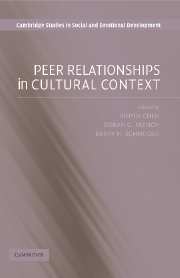Book contents
- Frontmatter
- Contents
- List of Contributors
- Introduction
- Part I Culture and Peer Relationships: Theoretical and Methodological Issues
- Part II Temperamental and Emotional Influences on Peer Relationships
- Part III Peers and Parents
- Part IV Peer Interactions and Social Behaviors
- Part V Friendships
- 17 Friendships of Indonesian, South Korean, and U.S. Youth: Exclusivity, Intimacy, Enhancement of Worth, and Conflict
- 18 The Cultural Practice of Close Friendships Among Urban Adolescents in the United States
- 19 Latino-Heritage Adolescents' Friendships
- 20 The Cultural Context of Children and Adolescents: Peer Relationships and Intimate Friendships Among Arab and Jewish Children in Israel
- Commentary III
- 21 Peers and Culture: Details, Local Knowledge, and Essentials
- Conclusion
- Author Index
- Subject Index
- References
21 - Peers and Culture: Details, Local Knowledge, and Essentials
from Commentary III
Published online by Cambridge University Press: 08 August 2009
- Frontmatter
- Contents
- List of Contributors
- Introduction
- Part I Culture and Peer Relationships: Theoretical and Methodological Issues
- Part II Temperamental and Emotional Influences on Peer Relationships
- Part III Peers and Parents
- Part IV Peer Interactions and Social Behaviors
- Part V Friendships
- 17 Friendships of Indonesian, South Korean, and U.S. Youth: Exclusivity, Intimacy, Enhancement of Worth, and Conflict
- 18 The Cultural Practice of Close Friendships Among Urban Adolescents in the United States
- 19 Latino-Heritage Adolescents' Friendships
- 20 The Cultural Context of Children and Adolescents: Peer Relationships and Intimate Friendships Among Arab and Jewish Children in Israel
- Commentary III
- 21 Peers and Culture: Details, Local Knowledge, and Essentials
- Conclusion
- Author Index
- Subject Index
- References
Summary
This commentary on the chapters in the friendship section by French, Lee, and Pidada; Azmitia, Ittel, and Brenk; Way, and Sharabany is organized around three questions: (a) how does one evaluate studies of culture, friendship, and peer relationships; (b) what can studies of cultural differences tell us about friendship and peer relationships; and (c) what can studies of friendship and peer relationships tell us about culture. Aside from the specific conclusions or substance of these chapters, these questions serve as an ever-present backdrop for our thinking about them. At the risk of repeating a basic premise underlying this volume, an irony of theory and research on peer relationships is the apparent assumption that peer relationships contribute to development in pretty much the same way in all places. This assumption is ironic in light of the frequent assumption that the significance and functions of the peer system are influenced by other aspects of the social and personal context. According to this assumption, the effects of peer relations will vary across children. If the effects of peer experiences are not “fixed,” even in a particular place, then why should we expect that they would not vary across places and cultures? The chapters that make up this section struggle with the question of how peer relationships intersect with cultural conditions.
Previously, it was proposed that there are at least three approaches to the study of peers and culture (Bukowski & Sippola, 1998).
- Type
- Chapter
- Information
- Peer Relationships in Cultural Context , pp. 481 - 486Publisher: Cambridge University PressPrint publication year: 2006

